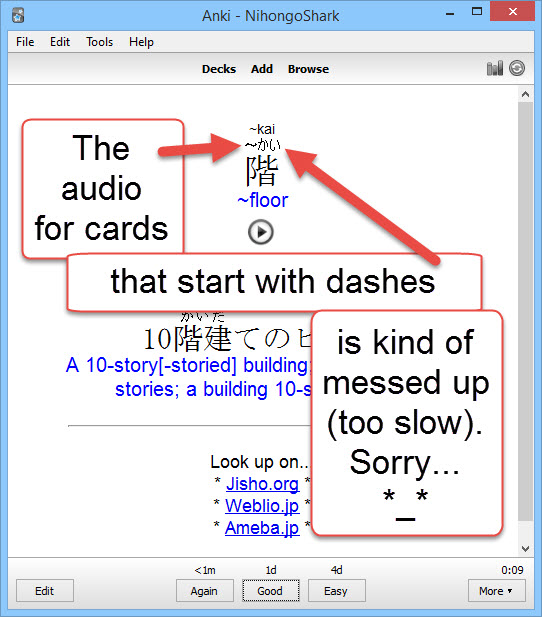If you want to pass JLPT N5, I really don't think you should be studying vocabulary lists. It would make a lot more sense to just find a comprehensive platform like NativShark, then study for a few months.
Then you should be able to pass the test with flying colors.
That said, about a decade ago, I did create a JLPT N5 vocabulary list, and that post can be found below.
JLPT N5 Vocabulary Lists
On this page, you'll find vocabulary lists in three different formats:
- Anki Flashcards with audio, definitions, and example sentences for JLPT N5 vocabulary.
- A PDF document with all that stuff.
- A spreadsheet (.csv) with all of the words, meanings, and example sentences.
Good luck on the test everyone!
JLPT N5 Anki Flashcards
I used to love using intelligent flashcards (i.e. Anki) in order to amass huge amounts of vocabulary. As I've gotten better at the language, I think people tend to rely on these types of programs too much, which is a shame as they limit context for acquiring new concepts, which is the thing that makes learning new concepts easier.
Anyway, I made some flashcard decks covering all of the words likely to show up on the JLPT N5 exam.

These flashcards were auto-generated using a number of free tools. In particular, I used the JLPT N5 List on this site and the JLPT N5 vocabulary list on this site, then transported those vocab lists into a spreadsheet, which I then used to auto-generate Anki flashcards using the EPWing2Anki program (instructions here), pulling definitions and example sentences from my digital copy of Kenkyusha's Japanese-English dictionary.

Once I got the flashcard deck created, I generated some (less than ideal) audio using the Anki add-on AwesomeTTS:

Example sentences have furigana thanks to this Japanese Support plugin.
Cards with audio have play buttons thanks to this reply audio button add-on:

How To Use These Flashcards
Some of you might be confused as to why the front side of my cards only has vocab, although usually I recommend using full sentences for the front side of your Japanese cards:

Adding to that, the front of the cards also have the reading of the target vocabulary words.
There are a few reasons I decided to go this route...
1) Cram JLPT N5 Words FAST
The purpose of this deck is less about increasing your communicative ability in Japanese and much more about boosting your Japanese vocabulary as quickly as possible.

People can argue about the most effective way to use flashcards all they want (I have lots of opinions about it, too, most of which I'm guessing you couldn't care less about). The thing is: It's faster to learn individual vocab words.
I didn't say that it's better. I'm simply saying that it's faster.
All we're trying to do is build up the foundation of vocab in your brain that you can later use to increase your communicative ability. I mean, a card like this doesn't really give you a lot of clues as to how you should use this word in a sentence:

But! It will help you out a lot both in test and down the road, once you have a Jedi-like grasp on Japanese sentence structure.
2) Don't Worry About the Kanji
I never put the readings of kanji on the front of my flashcards. Actually, I never put the readings of kanji on the back of my flashcards, either. But that's a different story.

Normally, I'd recommend having kanji-only on the front of your cards, then putting the readings on the back. But if you're cramming, you'll probably want to get through these fast. And having the reading on the front side certainly makes things faster.
Aside from that, some of the vocabulary words that show up on the JLPT N5 list have kanji that pretty difficult:

Although most Japanese people should be able to read that kanji (you actually see it kind of a lot in Japan, at festivals and such), you won't ever be required to do so on a test.
All you want to do for these cards is to understand what they mean when you see them. Some of you may want to put the readings of the kanji on the back (or use cloze deletion if you're feeling fancy), but I don't think it's really necessary. Also, it's really going to mess you up when you come across cards that don't have any kanji.
3) Go Fast... & Take Your Time?
I was super close to recommending that you set New Cards to 999 and Review Cards to 100 Max per day.
This would mean that every day, Anki limits your reviews to 100, but it allows you to study as many new words as you want. I do this sometimes for my anime flashcard decks, because I might go through 200 or more cards in a day, and I don't want to be overwhelmed with review cards later down the road.

Right now the setting is for 20 new cards per day, but you can change that however you'd like.
Anki Flashcard Deck Download Links
You can download this shared Anki deck from AnkiWeb's shared decks database.
Why Don't Example Sentences Have Audio?
I was kind of torn about this one, because I can't have furigana readings about the example sentences and also auto-generate audio for them using AwesomeTTS.

JLPT N5 Vocabulary List PDF & Spreadsheet
Update: I lost this PDF and Excel file. Oops.
But really, you shouldn't be studying Japanese in PDF's and spreadsheets. It's so inefficient!
Anyway, sorry.
Like I mentioned earlier, a high quality resource like NativShark would be much more effective.
Good luck with whatever path you choose, though!



